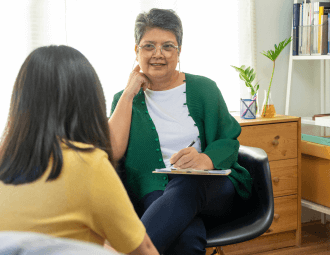Highlights
- Intrusive thoughts are unwanted and leave you feeling distressed, worried, or ashamed.
- It is normal to have occasional intrusive thoughts that are easy to dismiss and do not cause lasting distress.
- If intrusive thoughts are disrupting daily life, they might indicate an underlying mental health disorder, and it is essential to see a mental health professional.
- Intrusive thoughts can be managed with self-help techniques, therapy, and, if appropriate, medication prescribed by a doctor.
You’ve had some really bad thoughts recently, and you feel ashamed and confused. You can’t explain why this is happening; they just pop into your mind, and you’re starting to feel out of control.
It sounds like you might be experiencing intrusive thoughts, and the good news is you’re not alone. Let’s chat about this topic in detail and guide you on how to recognize and deal with intrusive thoughts.
Consult with a medical expert

What Are Intrusive Thoughts?
Firstly, you need to make sure that your thought ‘label’ is correct; it is important to understand what it means to have intrusive thoughts.
How Do You Know If a Thought Is Intrusive?
You can
- They are disturbing thoughts, meaning they go against what is moral or acceptable to you and society.
- They would usually have negative consequences.
- They
don’t serve a clear purpose[2] . - You fight acting on these negative thoughts.
- They are often repetitive thoughts.
- They are unplanned, unexpected, and involuntary thoughts that pop into your mind.
- They make you feel upset, worried, or ashamed.
- They can, unfortunately, last for years.
Intrusive thoughts are often confused with impulsive thoughts. However, impulsive thoughts are sudden urges to act, usually without considering the consequences. Typically, something specific triggers impulsive thoughts and, if acted on, would provide a feeling of relief, not distress.
Are Intrusive Thoughts Normal?
Yes, it is normal to have intrusive thoughts.
Interestingly, intrusive thoughts commonly occur in the general population, affecting

Examples of Intrusive Thoughts
The way that such thoughts manifest can be broken down into types of thoughts and common themes or subject matter.
Types of Intrusive Thoughts
Firstly, the three types of intrusive thoughts you may experience are:
- Pure thoughts
- Images in your mind
- Urges or thoughts of doing something
Pure Thoughts
These are just thoughts that cause distress, such as:
- During a meeting: “Everyone is staring at me because I didn’t wash my hair this morning.”
- Every time you have a mild headache: “What if I have brain cancer?”
Picture Thoughts
These are unwanted images that pop into your mind, for example:
- On a flight: Visualizing the plane crashing into the ocean.
- While driving: Picturing the car losing control and rolling off the road.
Thoughts About Suddenly Acting on Something
Sometimes, people have intrusive thoughts that are action-based and give them the urge to do something, like:
- Walking near someone on the street and having the urge to punch them in the face.
- At a work event having the urge to scream at the top of your lungs that you hate your boss.

Next, let’s cover the subject matter that is often involved.
Common Themes of Intrusive Thoughts
Harmful or Violent Thoughts
Any disturbing thought of hurting or harming yourself, a family member or a loved one, or even strangers. The intrusive thoughts might also revolve around injury and traumatic death.
Sexual Thoughts
These involve experiencing intrusive thoughts opposite to the person’s belief about sex. They might involve sexual orientation or identity, or undesirable or improper sexual scenarios. An example of a sexually intrusive thought is about going to a swingers’ party while you are in a happy monogamous relationship.
Religious Thoughts
Religious intrusions might be thoughts questioning the existence of a god or having an irrational fear of shouting something blasphemous during a religious event.
Relationship Concerns
Continuously thinking that a partner is cheating when they are 100% trustworthy.
Related to Negative Self-image
Having recurrent, unwanted, irrational negative thoughts about personal appearance or overwhelming self-doubt.
Embarrassment
Having unwanted thoughts about being humiliated or embarrassed, such as bed-wetting or arriving at a meeting unclothed.
Now that you know what to look for, why are you having these thoughts in the first place?
What Causes Intrusive Thoughts?
Do intrusive thoughts cause mental illness, or is it the other way around?
Sometimes, intrusive thoughts cause or predispose a person to poor mental health if not recognized and dealt with. They might trigger significant anxiety, worry, shame, paranoia, self-loathing, or anger. If repetitive, they might lead to depression, obsessive thoughts, or compulsive behaviors.
On the other hand, many underlying mental health disorders are associated with or cause intrusive thoughts.
Obsessive-Compulsive Disorder (OCD)
Common themes in obsessive-compulsive disorder include fear of contamination and intrusive thoughts about relationships, checking, and symmetry.
Post-Traumatic Stress Disorder (PTSD)
The intrusive thoughts in post-traumatic stress disorder (PTSD) are related to a past traumatic event. These flashbacks are essentially
Mood Disorders
People with depression and anxiety disorders are also prone to intrusive thoughts, which can be
Anxiety symptoms may include intrusive thoughts, but distressing thoughts also increase anxiety.
Postpartum Depression (PPD)
New parents have a difficult time because of poor sleep patterns, a sudden change in daily activities, and emotional and financial responsibility. This exhaustion and stress might contribute to intrusive thoughts about harm coming to their baby or wishing their baby had never been born.
About 2 out of 10 mothers are diagnosed with PPD, which predisposes them to these unwanted thoughts.
Eating Disorders
Importantly, having intrusive thoughts with any of the themes mentioned for the listed mental health disorders doesn’t mean you have the condition. The unwanted thoughts are only some symptoms that might occur, are not always present, and are not essential for a diagnosis. They are just warning flags.
How to Stop Intrusive Thoughts: 6 Tips
You can try some things at home to stop intrusive thoughts and how they make you feel; give these tips a go.
Give Yourself a Break
Don’t judge yourself. You’re not a bad person. Just recognizing that the thought is intrusive and knowing it’s normal to have it occasionally takes its negative power away. This will help the thought to pass more quickly.
Don’t Ignore the Thought
Just accept it. Fighting the thought might make it fight back for your attention, making it come back often and louder.
Try Thought Defusion
Thought defusion is a way to control intrusive thoughts by manipulating them in your brain. It might seem silly, but these methods often work; try them.
External voice | Instead of saying, “I have brain cancer.” say, “I’m having the thought that I have brain cancer.” This creates space between you and the intrusions and allows you to handle the negative thoughts more easily. |
Type it out | Imagine typing your disturbing thoughts in a Word document and then play with them by changing the font, color, and formatting. |
Passengers on the bus | Imagine yourself driving a bus. Treat unwanted thoughts as noisy passengers. See if you can keep driving rather than stopping when they want or trying to kick them off. Can you stay focused on driving your bus safely to your destination? |
Leaves on a stream | Manage intrusive thoughts by imagining they are autumn leaves falling and landing on a bubbling stream. Watch as they drift away out of sight. |
Practice Mindfulness
If unwanted thoughts are causing you distress, mindfulness is an excellent way to deal with the feelings and their physical responses. Also, if you feel less distress, you can think logically and recognize such thoughts as intrusive.
Mindfulness means:
- Being quiet and present in the moment
- Identifying your feelings and their physical manifestations at that point in time
- Not judging these emotions
Once you have done this, you can control and change these emotions by breathing or relaxing and taking power back.
An example of this is when you understand your nausea and shame are because of your intrusive thoughts, it is easier to let the thought go.
Learn Grounding Techniques
If you’re struggling with panic, worry, fear, or anxiety because of an intrusive thought, grounding helps to distract and calm the stress response.
Grounding brings your focus back to your direct, safe environment and reality. Some ways of doing this are:
- Counting backwards from 1000
- Naming all the orange items in the room
- Focusing on where your hands are and that your feet are firmly on the ground.
Get Enough Sleep and Reduce Stress Levels
Studies suggest that if you are sleep-deprived, your brain can’t block unwanted thoughts well; intrusive thoughts lead to anxiety, which might increase insomnia.
When to Seek Professional Help
Remember that we discussed that ‘normal’ intrusive thoughts are easy to let go of and don’t cause ongoing distress or worry. Reasons you should be concerned and get help immediately are when:
- Recurring thoughts are about hurting yourself or others
- Unwanted thoughts are affecting your day-to-day life and relationships
- Obsessive thoughts are causing you to have repetitive behaviors that are difficult to control
If you have stress-inducing symptoms, see a healthcare provider to learn more about the underlying problem and get appropriate support. MEDvidi’s medical team is experienced in providing online treatment for OCD, anxiety disorders, depression, and other mental health conditions that might cause intrusive thoughts.
Treatment for Intrusive Thoughts
The treatment options chosen by your healthcare provider will be unique and may include medication, a referral to a therapist, or both.
The cornerstone for thought change is a type of talk therapy called cognitive-behavioral therapy (CBT). The concept of CBT is that your thoughts, emotions, and behavior are all linked, and if you can change how you feel about a thought, you can alter how you act in response to it.
Medication can be chosen to treat the underlying mental health condition if there is one, and it isn’t always necessary.
Summing It Up
The best way to get rid of intrusive thoughts, if they are interfering with your quality of life, is to talk to a healthcare professional. They can assess your symptoms, rule out underlying conditions, or confirm a diagnosis of OCD, PTSD, anxiety disorder, or depression. You can see a licensed healthcare provider and go through such an assessment within just 24 hours by booking an appointment at MEDvidi.
FAQs
What if my intrusive thoughts are real?
Intrusive thoughts are usually not something you want, and do not mean you are a terrible person, especially if you can easily dismiss the thought. However, if they are disturbing or distressing, affecting daily life, you are hurting yourself, have suicidal feelings, or are making plans to harm others, seek help immediately.
How long do intrusive thoughts last?
Do intrusive thoughts ever go away?
Does everyone have intrusive thoughts?
Often, intrusive thoughts are normal, as reported by millions of Americans, and studies show that most people in many other countries also experience them. The important thing to recognize is that ‘normal’ intrusive thoughts are easy to let go of and don’t cause ongoing distress or worry. If this is not the case, you should see a mental health professional urgently.
How to help someone with intrusive thoughts?
You can help someone with intrusive thoughts by being understanding and not judging them. Always recommend professional help because you do not know the extent of their thoughts or mental health history.
What is the difference between intrusive and impulsive thoughts?
Intrusive thoughts are recurrent and distressing because they are about abnormal behavior and might have negative outcomes. The person fights against acting on an intrusive thought.
On the other hand, impulsive thoughts are short-lived, sudden urges to act, usually without considering the consequences. Something specific triggers them often, and if followed through, they provide relief, not distress.








